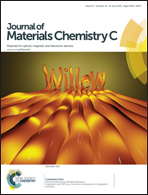White OLEDs based on a novel EuIII-tetrakis-β-diketonate doped into 4,4′-N,N′-dicarbazolebiphenyl as emitting material†
Abstract
Color tunable electroluminescence is obtained from devices having a spin-coated single emitting layer with a novel EuIII-tetrakis-β-diketonate complex NBu4[EuL4] (L− = 4-(4′-carbazol-9-yl-biphenyl-4-yl)-1,1,1-trifluoro-4-oxo-but-2-en-2-ol anion) doped with CBP (4,4′-N,N′-dicarbazolebiphenyl)–OXD7 (1,3-bis[2-(4-tert-butylphenyl)-1,3,4-oxadiazo-5-yl]benzene) blend. An external quantum efficiency (EQE) as high as 2.8%, maximum brightness (L) of 1547 cd m−2, current efficiency (ηc) of 5.14 cd A−1 and power efficiency (ηp) of 2.53 lm W−1 were shown by a device having the structure ITO/PEDOT:PSS (50 nm)/CBP (56%):OXD7 (24%):NBu4[EuL4] (20%) (50 nm)/TPBI (50 nm)/LiF (1.5 nm)/Al (120 nm). The newly designed β-diketonate ligand containing hole-transporting carbazole group and π-spacer extends the excitation window of the EuIII-complex to 450 nm and also improves the carrier transport properties. The modification in the ligands results in a low turn-on voltage of the devices (<5 V). Furthermore, the devices containing 10–20% NBu4[EuL4] in the emitting layers show white emission in a wide voltage range (8–13 V) with sizable efficiencies.


 Please wait while we load your content...
Please wait while we load your content...